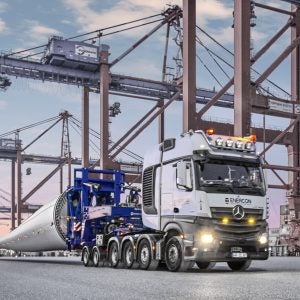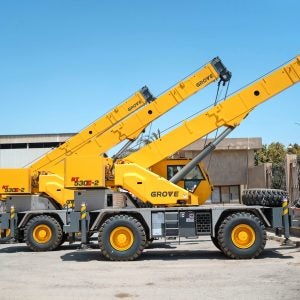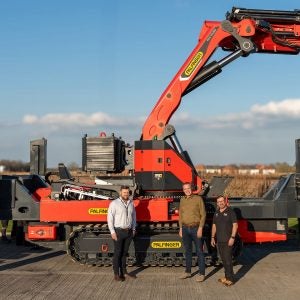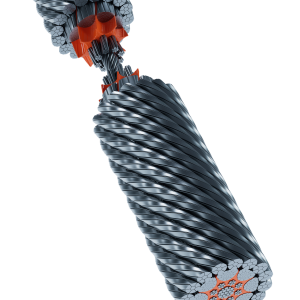When Mitsubishi Heavy Industries awarded a contract last year to Van Seumeren to lift roof sections on a stadium under construction, it was an unusually high profile contract. This project was at Miller Park in Milwaukee, USA, to take over in the wake of an accident which saw three men killed when Lampson’s Transi-Lift crawler crane toppled over. While investigations continued into the accident, construction had to press on; and Mitsubishi decided that until Lampson’s equipment was officially exonerated, a new contractor with different equipment had to be called in. Van Seumeren not only had the necessary credentials, it also had the right machine – its Demag CC 12600 was just finishing a job in Texas.
Van Seumeren’s credentials are well established: the Dutch company is a world leader in heavy lifting. It has also worked on several famous sports stadiums, including the Amsterdam Arena, home to soccer’s AFC Ajax, and the Louzniki Olympic Stadium in Moscow.
It is always a pressure job, operating a 1,600t capacity machine – the CC 12600 is the world’s biggest single body crawler crane – but when you are taking over on a project that is so much in the glare of publicity, the pressure must be doubled. So who did Van Seumeren send for this assignment? The boss’s son.
Frans van Seumeren Jr is the 31 year old son of the company president and chief executive Frans Sr. It is very much a family business. The founder, Jan van Seumeren, died last year but his three sons Frans Sr, Jan and Roderik, and his four grandchildren, make up something of a dynasty. Frans Jr’s younger sister Larissa works in the public relations department, while one cousin – Jan Jr – works with his father trading used equipment, and another cousin – Patrick Freericks – is on the commercial side. But a desk job was not for Frans Jr.
“I started working full time for Van Seumeren almost 15 years ago, at the age of 16,” he says. “Before that, I only worked when I had school vacations. In contrast to my other family members who work at Van Seumeren I chose the ‘doing’ part of the job. I like being outside everyday, and I am not an office type of guy.” He has worked his way up from smaller cranes, to practically the very biggest that the company – and the world – has to offer. “I started working on various hydraulic cranes. When I had enough experience, I became the crane operator on the TC 3000 we used at that time. Later I worked on a number of Demag CC 4800 cranes and I worked for about a half year on the heavy lift crane barge The Rambiz in Lisbon, Portugal where we were building the Vasco da Gama Bridge over the Tagus river.” Van Seumeren took delivery of the CC 12600 in December 1996 and Frans Jr has been on it from the outset. Before taking over, he and others spent a month at Demag on a training course.
It is quite a machine: up to 114m of main boom and a maximum 84m jib; able to lift 1,600t at 22m radius, 800t at 42m and 400t at 70m. It can crawl with full load on main boom and with 75% load on the jib.
“The first job we did with the crane was in Germany where we built a a new power plant,” he recalls. “We lifted construction parts up to 160t. After this we went to Belgium. There, we had to salvage a collapsed harbour crane weighing 1,100t.
“Then I went to Scotland for about six months to work on a shipyard. We had to install a number of items on a FPSO vessel. The heaviest lift we performed there was a living quarters module, which weighed 1,230t. After that we won a contract in Venezuela. We worked on an oil refinery, exchanging a 500t reactor head of a flexicoker installation.
“As you can see, being a permanent crane operator on the Demag 12600 means a lot of travelling around the world. But in fact that’s what I found the best part of my job. I like the adventurous side of it, meeting new cultures, seeing different countries. Every country has its own way of handling things. They have their own mentality, culture and language: English, Spanish, German, French, Arabic, etc. Usually it takes a bit of getting used to each other because of the Van Seumeren mentality. We are used to making quick decisions when necessary and we keep working until the job is done. But so far everything has turned out well. In the case of the project we did in Venezuela, it turned out very well for me personally because I met my current girlfriend there!” Frans Jr was already in the USA prior to the Miller Park contract, working at Port Arthur in Texas, on the construction of a coke facility for Foster Wheeler. “When we finished that project, we dispatched the CC 12600 to Milwaukee. That was in November of last year,” he says.
Construction of the Miller Park stadium began back in November 1996. It is to be a new home for the Milwaukee Brewers baseball team, replacing the County Stadium that has been the home of the Milwaukee Braves and Milwaukee Brewers since 1953.
When the stadium is completed, scheduled for April 2001, it will be one of the heaviest structures in Wisconsin at about 450,000t. The materials used to build Miller Park include an estimated 40km of deep piles, about 54,000m3 of structural concrete, roughly 4,600 precast concrete sections and approximately 22,000t of structural steel.
But the Van Seumeren crew won’t be in town long enough to admire the finished product. “By that time we will already be executing another challenging job, perhaps on another continent,” he says.
Lampson’s stricken crane had been nicknamed Big Blue. The local press in Milwaukee, which has been following the triumphs and disasters on the project with equal diligence, has already come up with a nickname for Van Seumeren’s Demag crane… “They call it the Big D,” says Frans Jr.






